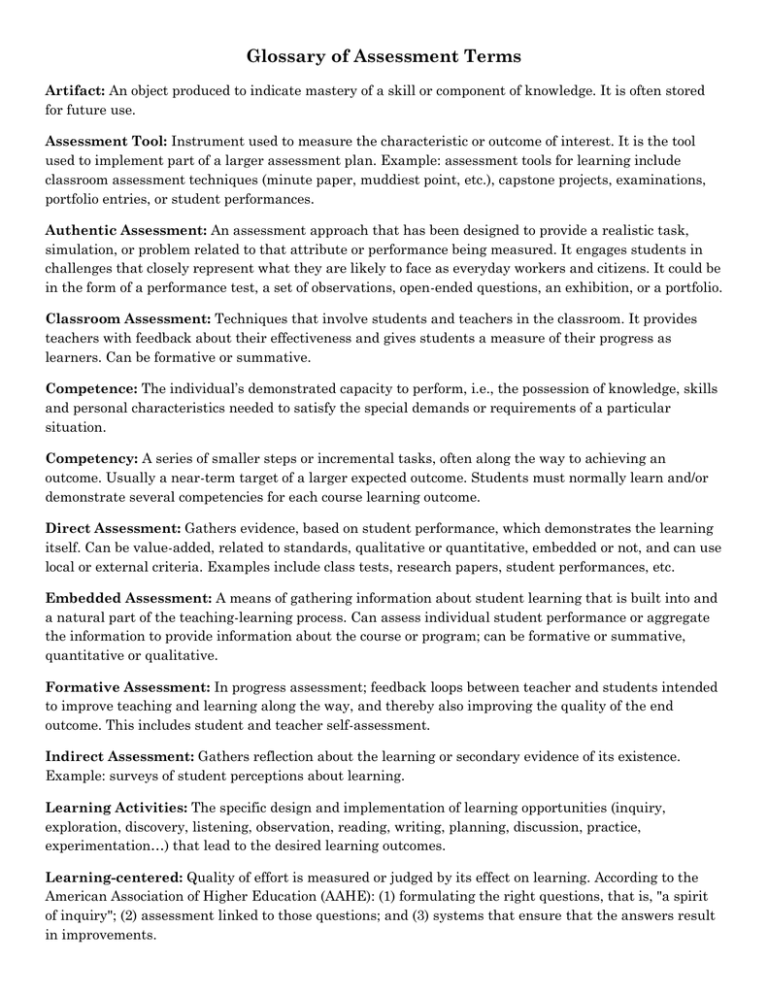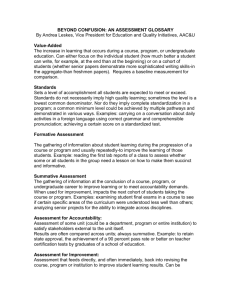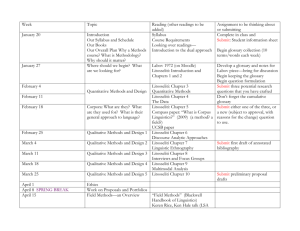Glossary of Assessment Terms
advertisement

Glossary of Assessment Terms Artifact: An object produced to indicate mastery of a skill or component of knowledge. It is often stored for future use. Assessment Tool: Instrument used to measure the characteristic or outcome of interest. It is the tool used to implement part of a larger assessment plan. Example: assessment tools for learning include classroom assessment techniques (minute paper, muddiest point, etc.), capstone projects, examinations, portfolio entries, or student performances. Authentic Assessment: An assessment approach that has been designed to provide a realistic task, simulation, or problem related to that attribute or performance being measured. It engages students in challenges that closely represent what they are likely to face as everyday workers and citizens. It could be in the form of a performance test, a set of observations, open-ended questions, an exhibition, or a portfolio. Classroom Assessment: Techniques that involve students and teachers in the classroom. It provides teachers with feedback about their effectiveness and gives students a measure of their progress as learners. Can be formative or summative. Competence: The individual’s demonstrated capacity to perform, i.e., the possession of knowledge, skills and personal characteristics needed to satisfy the special demands or requirements of a particular situation. Competency: A series of smaller steps or incremental tasks, often along the way to achieving an outcome. Usually a near-term target of a larger expected outcome. Students must normally learn and/or demonstrate several competencies for each course learning outcome. Direct Assessment: Gathers evidence, based on student performance, which demonstrates the learning itself. Can be value-added, related to standards, qualitative or quantitative, embedded or not, and can use local or external criteria. Examples include class tests, research papers, student performances, etc. Embedded Assessment: A means of gathering information about student learning that is built into and a natural part of the teaching-learning process. Can assess individual student performance or aggregate the information to provide information about the course or program; can be formative or summative, quantitative or qualitative. Formative Assessment: In progress assessment; feedback loops between teacher and students intended to improve teaching and learning along the way, and thereby also improving the quality of the end outcome. This includes student and teacher self-assessment. Indirect Assessment: Gathers reflection about the learning or secondary evidence of its existence. Example: surveys of student perceptions about learning. Learning Activities: The specific design and implementation of learning opportunities (inquiry, exploration, discovery, listening, observation, reading, writing, planning, discussion, practice, experimentation…) that lead to the desired learning outcomes. Learning-centered: Quality of effort is measured or judged by its effect on learning. According to the American Association of Higher Education (AAHE): (1) formulating the right questions, that is, "a spirit of inquiry"; (2) assessment linked to those questions; and (3) systems that ensure that the answers result in improvements. Measure: To collect quantitative and/or qualitative data to be analyzed. Qualitative data are data that do not lend themselves to quantitative methods but rather to interpretive criteria, for example, interviews, focus groups, and anecdotal evidence. Objective: An objective describes what a student should know or be able to do at the end of a specific lesson plan. It is observable and measurable. Outcome: A statement of what a student should understand and be able to do as a result of what he or she has learned in a course or program. Outcomes Assessment (OA): The measurement of learning outcomes. OA examines student demonstrations of the results of learning. The process includes four cyclical steps: 1) teaching and learning, 2) developing questions and gathering information about student learning, 3) analyzing the information and drawing conclusions, and 4) reflecting and planning. It documents the alignment (or dissonance) between the intended learning (as stated in the outcomes) and the actual learning (as demonstrated by the student). The practice of Outcomes Assessment is collaborative and is intended to inform. Its goal is to continually improve student learning. Performance-Based Assessment: A type of student evaluation that requires a student to perform a task and be evaluated using indicators/criteria for performance (rather than traditional testing methods such as selecting an answer from an existing list.) Portfolio: Compilation of evidence demonstrating a level of development of essential competencies and the achievement of specific learning outcomes. The portfolio serves as a tool for both formative and summative assessment. A portfolio is a repository of professional and/or academic work. Program: The term “program” refers to a degree or certificate offered by the college. Qualitative Assessment: Collects data that does not lend itself to quantitative methods but rather to interpretive criteria. Example, interviews, focus groups, antidotal evidence. Quantitative Assessment: Collects data that can be analyzed using quantitative methods. Reliability: The “reproducibility” of a measure. A measurement procedure that when reproduced gives similar results. Rubric: A rubric is a scoring tool that lists the criteria for a piece of work, or “what counts” (for example, purpose, organization, details, voice, and mechanics are often what count in a piece of writing); it also articulates gradations of quality for each criterion, from excellent to poor. Self-Assessment: Self-assessment is the process of doing a systematic review of one’s own performance, usually for the purpose of improving future performance. Such assessment may involve comparison with a standard or established criteria. Self-assessment may involve critiquing one’s own work or may be a simple description of one’s performance. Standards: A set level of accomplishment all students are expected to meet or exceed. (Standards are not always high quality as sometimes the level is the lowest common denominator. Standards also do not imply complete standardization in a program because common minimum standards can be achieved by multiple pathways and demonstrated in multiple ways.) Summative Assessment: Measures of performance at given "finish points" in a course, at course/program conclusions, at graduation, etc. Summative assessment may include student selfassessment. Tests and papers are kinds of summative assessment. Grades are reflections of individual teacher evaluations of student performance on series of tests and papers. References: Angelo, T. A. "Reassessing (and Defining) Assessment." The AAHE Bulletin, 4B (2), November 1995. Angelo, T. A. & Cross, K. P. (1993). Classroom Assessment Techniques: A Handbook for College Teachers. Jossey-Bass. Banta, Trudy W. and Palomba, Catherine A. (1999). Assessment Essentials, Planning, Implementing, and Improving Assessment in Higher Education. Jossey-Bass. Cross, K. P. & Steadman, M. H. (1996). Classroom Research: Implementing the Scholarship of Teaching and Learning. Jossey-Bass. Leskes, A. (2002). “Beyond Confusion: An Assessment Glossary.” American Association of Colleges and Universities. Pohl, Michael, for the QSITE Higher Order Thinking Skills Online Course 2000, "Bloom's (1956) Taxonomy Revised," oz-TeacherNet: http://rite.ed.qut.au/oz-eachernet/training/bloom.html. Swing, R. Institutional Research Basics: An Overview of Assessment in Higher Education. Http://www.panda.auburn.edu/sair/2-0220-WK.pdf Teacher Evaluation Kit Glossary http://www.wmich.edu/evalctr/ess/glossary/glos-a-d.htm Valencia Community College Office of Curriculum Development, Teaching and Learning. Wiggins, Grant. Online Resource Glossary: Assessment Glossary: http://www.uwlax.edu/provost/assessment/A-golossary.htm





